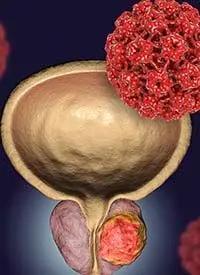Article
Adding ADT to post-RP salvage RT boosts outcomes in patients with elevated PSA
Author(s):
Data from the phase 2 GETUG-AFU 22 trial showed that adding degarelix to post-operative immediate salvage radiotherapy improved metastasis-free survival in this patient population.

Adding a short-term course of the androgen deprivation therapy (ADT) degarelix (Firmagon) to post-operative immediate salvage radiotherapy (iSRT) reduced the risk of metastases or death by 49% in patients with a persistently elevated PSA following radical prostatectomy (RP).1
Data from the phase 2 GETUG-AFU 22 trial presented at the 2022 ASTRO Annual Meeting showed that the 5-year metastasis-free survival (MFS) rate was 91.44% (95% CI, 80.64-96.35) with iSRT plus ADT vs 78.59% (95% CI, 65.99-86.97) with iSRT alone (HR, 0.51; 95% CI, 0.26-0.99; P = .048).
“MFS, as a predictive marker for survival, favored the addition of short term ADT plus iSRT in this population compared to iSRT alone,” said lead study author Igor Latorzeff, MD, Groupe Oncorad Garonne, Toulouse, France.
Although there was not a statistically significant difference in event-free survival (EFS) between the 2 arms, Latorzeff said that with 53 EFS events, “the probability in this population that iSRT plus ADT is actually better than iSRT alone is 79%.”
Explaining the background of the study, Latorzeff said, “Overall, 5% to 20% of patients undergoing radical prostatectomy experience PSA persistence with postoperative PSA >0.1 ng/ml 6 to 8 weeks after surgery. PSA persistence is a high risk factor for biochemical recurrence, metastatic disease, and cancer-specific death.”
The open-label GETUG-AFU 22 trial (NCT01994239) accrued patients with localized prostate adenocarcinoma treated with RP who had a post-RP PSA level between 0.2 and 2 ng/mL and no clinical signs of progressive disease. Between December 2012 and September 2015, there were 125 patients enrolled in the trial.
Overall, patient characteristics were well balanced between the 2 arms. Across all 125 patients, the median patient age was 66 years (range, 50-77). The median Gleason score was 7 (range, 3-9). ECOG performance status was 0 for 114 patients, 1 for 10 patients, and missing for 1 patient. The median post-operative PSA prior to iSRT was 0.6 ng/mL (range, 0.12-3.65).
Residual tumor classifications were R0 (32.8%), R1 (65.6%), andRx (1.6%). pT stages were T1 (0.8%),T2 (36%), and T3 (63.2%). pN stages were N0 (82.4%) and Nx (17.6%).
Latorzeff did note that there were more patients with negative tumor margins (R0) in the ADT arm vs the iSRT-alone arm at 24 vs 17, respectively.
Patients were randomized to iSRT+ ADT (degarelix; 61 patients) or iSRT alone (64 patients). iSRT consisted of 46 Gy of pelvic radiotherapy delivered in 23 fractions of 2 Gy plus a boost of the prostate bed up to 66 Gy (33 fractions). Patients randomized to the experimental arm received the same course of iSRT plus 6 months of concomitant degarelix, which was administered with an initial dose of 240 mg followed by 5 maintenance doses of 80 mg monthly.
The primary end point was EFS, with secondary end points including MFS, overall survival, QOL, and safety. The median follow-up was 74.94 months.
At 5 years, the median EFS was not reached in either arm. The EFS rate was 62.3% (95% CI, 48.9-73.2) in the control arm versus 63.4% (95% CI, 49.9-74.2) in the iSRT plus ADT arm (HR, 0.83; 95% CI, 0.47-1.47; P = .528).
Latorzeff said the researchers assessed second cancers and reported that there were 3 second cancers in the control arm (bladder, oral cavity, and lung) and 6 in the combination arm (multiple myeloma, lung, glioma, bladder, and 2 colorectal cancers). He noted that the second cancers were not related to treatment performance.
There was 1 death (severe infection) in the iSRT-alone arm and 5 deaths in the iSRT plus ADT arm (dementia, multiple myeloma, colorectal, glioma, polyarteritis nodosa). None of these deaths was related to prostate cancer, according to Latorzeff.
In his concluding remarks, Latorzeff said that there are ongoing trials aiming to confirm the researchers’ hypothesis that adding ADT to iSRT improves outcomes in this population, including the phase 2 STEELE, Formula-509, and BALANCE trials, and the phase 2/3 NRG-GU002 trial.
Reference
1. Latorzeff I, Guerif S, Castan F, et al. GETUG-AFU 22: Phase II Randomized Trial Evaluating Outcomes of Post-Operative Immediate Salvage Radiation Therapy with or without ADT for Patients with Persistently Elevated PSA Level. Presented at 2022 American Society for Radiation Oncology Annual Meeting (ASTRO); October 23-26, 2022; San Antonio, TX. LBA 10.

















